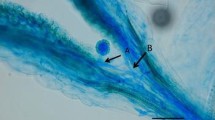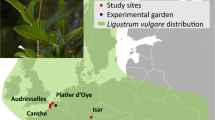Summary
Diallels and backcrosses among self-incompatible (SI) clones and progeny of Ageratum houstonianum Mill. could be organized into intra-incompatible classes. Four of 5 progenies segregated in expected ratios of S genotypes. Ageratum expressed a one-locus incompatibility system of the sporophytic type with a linear dominance series of multiple alleles and complete allelic dominance in both pollen and stigma. In the second part of the study, a high percentage of self-seed set was observed during the first flowering of a progeny from a pseudo-self compatible (PSC) seed source. Six progenies were derived from the PSC seed source. Five of the 6 segregated PSC ∶ SI plants, 4 of which fit a 3 ∶ 1 ratio of PSC ∶ SI plants. All plants of the sixth progeny were SI. Two F1 progenies with the same PSC pollen parent produced significantly different segregations of PSC ∶ SI plants. It appeared that PSC acted as a major gene when the most recessive S allele was also present, but PSC was not expressed when the most dominant S allele was present. Clones propagated from PSC plants were SI and cross incompatible with a related S-allele tester. Thus, PSC was transient in that it was apparent in seed-propagated plants but not in plants clonally propagated from the PSC individuals.
Similar content being viewed by others
Literature
Ascher, P.D. (1976): Self-incompatibility systems in floriculture crops. Acta Hortic. 63, 205–215
Brewer, J.G.; Parlevliet, J.E. (1969): Incompatibility as a new method for identification of pyrethrum clones. Euphytica 18, 320–325
Crowe, L.K. (1954): Incompatibility in Cosmos bipinnatus. Heredity 8, 1–11
Drewlow, L.W.; Ascher, P.D.; Widmer, R.E. (1973): Genetic studies of self incompatibiliy in the garden chrysanthemum. Theor. Appl. Genet. 43, 1–5
Eenink, A.H. (1981): Compatibility and incompatibility in witloofchicory (Cichorium intybus L.). 2: The incompatibility system. Euphytica 30, 77–85
Gerstel, D.U.; Riner, M.E. (1950): Self-incompatibility studies in guayule. 1: Pollen-tube behavior. J. Hered. 41, 49–55
Gerstel, D.U. (1950): Self-incompatibility studies in guayule. 2: Inheritance. Genetics 35, 482–506
Habura, E. (1957): Parasterilität bei Sonnenblumen. Z. Pflanzenzücht. 37, 280–298
Hughes, M.B.; Babcock, E.B. (1950): Self-incompatibility in Crepis foetida (L.) subsp. rhoedifolia. Genetics 35, 570–588
Imrie, B.C.; Knowles, P.F. (1971): Genetic studies of self incompatibility in Carthamus flavescens. Crop Sci. 11, 6–9
Reimann-Phillipp, R. (1965): The application of incompatibility in plant breeding. In: Genetics today 3, pp. 649–656. The Hague: XI. Int. Cong. Genet. 1963
Author information
Authors and Affiliations
Additional information
Communicated by H. F. Linskens
Scientific Journal Series Paper Number 12,299 of the Minnesota Agricultural Experiment Station
Rights and permissions
About this article
Cite this article
Stephens, L.C., Ascher, P.D. & Widmer, R.E. Genetics of self incompatibility in diploid Ageratum houstonianum mill. Theoret. Appl. Genetics 63, 387–394 (1982). https://doi.org/10.1007/BF00303913
Accepted:
Issue Date:
DOI: https://doi.org/10.1007/BF00303913




